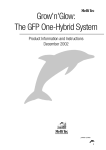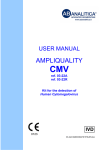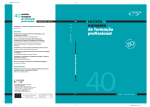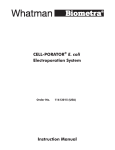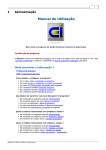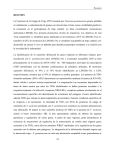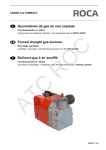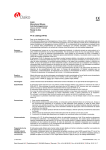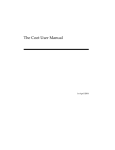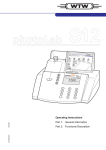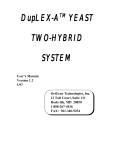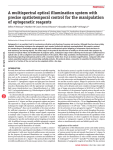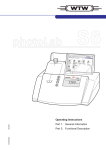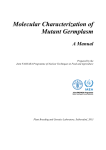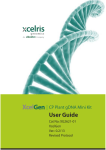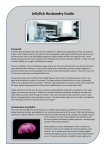Download User`s manual - Boca Scientific Laboratory Products
Transcript
GROW'N'GLOW: THE ACE1 TWO-HYBRID SYSTEM PRODUCT INFORMATION AND PROTOCOLS JANUARY 2001 GROW'N'GLOW: THE ACE1 TWO-HYBRID SYSTEM HANDBOOK 2001 Mo Bi Tec GmbH Lotzestrasse 22a, D-37083 Göttingen Tel: ++49 551 707 22-0 Fax: ++49 551 707 22-22 E-mail: [email protected] or [email protected] INTERNET http://www.mobitec.de ACE1 01/2001 1 Content 1. 1.1. 1.2. 1.3. 2. 3. 4. 4.1. 4.2. 4.2.1. 4.2.2. 4.2.3. 4.3. 5. 5.1. 5.1.1. 5.1.2. 6. 7. 7.1. 7.2. 7.2.1. 7.2.2. 7.3. 7.4. 7.5. 7.6. 7.6.1. 7.6.2. 7.6.3. 7.7. 8. 9. 10. page Introduction ................................................................... 4 General ............................................................................. 4 Background ....................................................................... 4 GFP .......................................................................... 6 Schematic Overview of the Grow'n'Glow ACE1 System .... 7 Advantages of the Grow'n'Glow ACE1 System ................ 8 Kit Components: "Complete Kit" ...................................... 8 Yeast Strains ....................................................................... 9 DNA Vectors .................................................................... 10 Bait Plasmid pTY137 ............................................................. 10 Prey Plasmid pTM114 ............................................................ 10 Control Plasmids ................................................................... 11 Primer ............................................................................. 12 Materials Required, but not Supplied ........................ 13 Recipes for Media ............................................................ 13 Grow'n'Glow Yeast Growth Media ......................................... 14 Grow'n'Glow Bacterial Growth Media .................................... 15 Growth and Maintenance of Yeast ................................. 16 Grow'n'Glow Two-Hybrid System Protocol ..................... 16 Constructing the Hybrid Gene ACE1BD-Bait ....................... 16 Autoactivation of CUP1 ..................................................... 17 Yeast Transformation Protocol ................................................. 17 Testing Procedure for CUP1 Autoactivation .............................. 17 Autoactivation of GFP ....................................................... 18 Large-Scale Library Screen Protocol ................................... 19 Green Fluorescent Protein (GFP) Assay Protocol .................. 20 Further Characterization of Putative Positives ...................... 21 Plasmid Isolation from Yeast ................................................... 21 Transformation of E. coli with Plasmids Isolated from Yeast ....... 21 Prey Plasmid Identification by PCR .......................................... 22 Other Verification Methods of Protein-Protein Interaction ..... 23 Literature ..................................................................... 23 Appendix .................................................................... 25 Appendix I: Small Scale Yeast Transformation Procedure ..... 25 Appendix II: Large Scale Yeast Transformation Procedure ... 26 Appendix III: Isolation of Plasmids from Yeast ...................... 28 Appendix IV: Transformation of competent E. coli Cells ........ 29 Order Information, Shipping and Storage ...................... 31 ACE1 01/2001 2 The Grow'n'Glow ACE1 two-hybrid system was developed by Dr. Thomas Munder at the HansKnöll-Institut, Jena, Germany. General knowledge: Users of the kit should be familiar with basic molecular biology and microbiological techniques! NOTE: FOR RESEARCH PURPOSES ONLY! NOT FOR DIAGNOSTIC OR THERAPEUTIC USAGE. We will replace, at no cost, any product of ours that does not meet our standard product specifications. No other warranties, expressed or implied, are given with our products. MoBiTec GmbH is not liable for any damages due to the use of this product nor are we liable for the inability to use this product. PLEASE NOTE THAT THIS KIT IS FOR USE BY THE PURCHASER ONLY AND IS NOT TO BE DISTRIBUTED TO THIRD PARTIES WITHOUT THE WRITTEN CONSENT OF MOBITEC GMBH. Licence for GFP: This product is sold under licence from Columbia University, USA. Rights to use this product are limited to research use only; NOT FOR DIAGNOSTIC OR THERAPEUTIC USE IN HUMANS OR ANIMALS. No other rights are conveyed. Inquiry into availability of a license to broader rights or the use of this product for commercial purposes should be directed to Columbia Innovation Enterprise, Columbia University, Engineering Terrace-Suite 363, New York, New York 10027, USA. Licence for Two-Hybrid Technology: Practice of the two-hybrid system is covered by U.S. Patents Nos. 5,283,173, 5,468,614 and 5,667,973 assigned to The Research Foundation of the State University of New York, USA. Purchase of any two-hybrid reagents does not imply or convey a licence to practice the two-hybrid system covered by these patents. Commercial entities in the U.S.A. practicing U.S. Patent No. 5,283,173 must obtain a licence from The Research Foundation of State University of New York. Non-profit institutions may obtain a complimentary licence for research not sponsored by industry. Please contact Barbara A. Sawitsky at The Research Foundation of SUNY at Stony Brook for licence information (phone 516/632-4163, fax 516/632-9839). ACE1 01/2001 3 1. Introduction 1.1. General The yeast two-hybrid system1 or interaction trap2 has rapidly become a widely used technique in molecular biology. It is now the method of choice to identify protein-protein interactions from either cDNA libraries or known gene sequences3. The method relies on the transactivation of reporter genes in Saccharomyces cerevisiae to identify positive interactions. In common twohybrid systems, growth selection via activation of either a HIS3 or LEU2 reporter gene is used in conjunction with a second reporter gene, such as LacZ, which expresses β-galactosidase. The use of two reporter genes enables discrimination of false positives which activates only the auxotrophic marker. Yeast colonies that survive the growth selection scheme are chosen, re-streaked and tested for expression of the LacZ gene by means of a filter assay or growth on minimal medium plates containing 5-bromo-4-chloro-3-indolyl-β-D-galactopyranoside (X-Gal). This latter step can often be time-consuming depending on the number of primary transformants obtained. In order to simplify and accelerate the screening process of the two-hybrid systems and improve selection of positive clones, a yeast strain was constructed containing both the gene encoding the green fluorescent protein (GFP) from the bioluminescent cnidarian Aequorea victoria4 and the metallothionein encoding CUP1 gene5. 1.2. Background MoBiTec's ACE1-based Grow'n'Glow yeast two-hybrid system is a version of a system originally developed by Fields and Song1. The yeast two-hybrid system has proven to be a powerful tool for identifying proteins from an expression library which can interact with one's protein of interest. The technology is based on the fact that many eukaryotic transcriptional activators, such as GAL4, consist of two physically separable modular domains, one DNA-binding domain and one transcriptional activation domain. In order to activate transcription, they have to be physically tethered to one another, and neither of them can activate transcription on its own. The same basic idea is followed in ACE1-based yeast two-hybrid systems where the DNA-binding and transcriptional activation domains of the yeast transcription factor ACE1 are used6,7. Binding of this transcription factor to DNA is dependent on the presence of copper ions that induce a conformational change in the N-terminus of ACE1, allowing the protein to interact with DNA5. The conventional reporter gene generally used with yeast two-hybrid systems is β-galactosidase. ACE1 01/2001 4 The new Grow'n'Glow ACE1 System was developed at the Hans Knöll Institute in Jena as a more versatile and more accurate version of the yeast two-hybrid system, since it is using the reporter gene GFP. The practical advantages of this fluorescent protein over β-galactosidase are substantial. In a typical β-Gal screen, individual surviving yeast colonies are picked and then tested for βgalactosidase activity either by a filter assay or growth on minimal medium plates containing X-Gal. Both procedures are often labor-intensive, especially when hundreds of yeast colonies are obtained. In contrast, when GFP is used as the reporter, the selection plates containing the yeast colonies are simply placed under a UV lamp (without the lid!) and positives become immediately identifiable by their green fluorescence. In summary, the GFP gene, stably integrated in the yeast chromosome, is a valuable addition to the family of reporter genes for two-hybrid systems and makes a secondary screening of yeast colonies faster and more cost-effective than conventional LacZ assays. Detection of protein-protein interactions via the green fluorescent protein provides global screening of colonies without bias and can be adapted to most yeast-based two-hybrid strategies. In addition, the copper resistance-mediating CUP1 reporter gene, also stably integrated in the yeast chromosome, allows a more stringent and even modulatory selection of positive clones on media containing copper ions. Discrimination between strong or weak protein interactions at an early step can be achieved by different copper concentrations in the medium. Since only those cells expressing well-interacting proteins can endure the toxicity of copper ions, the stringency of the CUP1-mediated growth selection can be modulated by different concentrations of CuSO4. Strong interactors should be distinguished readily from weak interactors by comparing CUP1 expression: the growth of yeast cells expressing low-affinity interacting proteins will be much more depressed on copper-containing medium than that of cells expressing proteins with a high binding affinity to one another. Furthermore, weak interactors determine weak GFP expression: the GFP signal of those cells is greatly reduced compared to cells expressing strongly interacting hybrid proteins. Furthermore, this novel two-hybrid system is also suited for the development of high-throughput-screening assays to screen for compounds affecting the interaction between therapeutic relevant proteins. Since the GFP reporter expression is initiated solely by the addition of copper ions (binding of the ACE1BD to DNA is dependent on the presence of copper ions!), incubation of cells with an inhibitory drug followed by the addition of copper should give clearly reduced GFP activities. In non-inducible systems, the reporter gene (e.g. β-galactosidase) is expressed during the whole fermentation process of the yeast cells before the addition of the inhibitory compound. Thus, the already existing level of the reporter protein makes it difficult to measure any inhibitory effect. ACE1 01/2001 5 1.3. GFP The GFP of the jellyfish A. victoria is activated in vivo by an energy transfer via the Ca2+-stimulation of the photoprotein aequorin8. The blue light generated by aequorin excites GFP and results in the emission of green light. GFP itself consists of 238 amino acids (Mr = 27 kDa) and is synthesized as an apoprotein in which post-translational formation of the chromophore occurs in an O2-dependent manner independent of any other gene products9,4. It maximally absorbs light at 395 nm and has an emission peak of 509 nm. The nonsubstrate requirement for GFP activity makes this protein an attractive reporter for gene expression studies and this utility was initially demonstrated in both prokaryotes (Escherichia coli) and eukaryotes (Caenorhabditis elegans)9. It has subsequently been used to monitor gene expression in many organisms including mouse10, Drosophila11, zebrafish embryos12, Arabidopsis13 and yeast14. In addition to the non-invasiveness of GFP detection (long-wave UV light) the protein is very stable, non-toxic and resistant to photobleaching. These properties make GFP a viable alternative to traditional reporter genes such as β-galactosidase (LacZ), β-glucuronidase (GUS), chloramphenicol acetyl transferase (CAT) or firefly luciferase which require substrate for their detection. Several modifications of the wild-type GFP cDNA have been engineered with optimized codon usage, improved fluorescence activity and red-shifted variants with altered excitation maxima intended for fluorescence microscopy4. The A. victoria GFP variant GFPuv is optimized for maximal fluorescence by UV-light excitation making it fluoresce 18 times brighter than wildtype GFP while retaining identical excitation and emission wavelength maxima. The GFP reporter allows a very sensitive direct detection in living cells without the time-consuming necessity of preparing cell extracts. Clones expressing interacting proteins are easily detected by placing the plate with the colonies under a UV handlamp in the dark room. Since the detection of the GFP signal does not require cell lysis it allows the monitoring of reporter gene activity as a function of time, especially if a fluorescence spectrophotometer is used for measurement of whole cell fluorescence. Legend to flow chart on page 7: Identification of molecular interactions with the Grow'n'Glow ACE1 Two-Hybrid System. To test whether the bait protein activates the reporter genes on its own ("autoactivation"), only the bait vector with the target gene istransformed into yeast. (Alternatively, you can co-transform yeast strain ITH5 with the bait vector carrying your target gene and the "empty" prey vector.) Clones growing on medium containing CuSO4 and/or fluorescing green under UV-light are not suitable for a two-hybrid screen. Clones which do not grow on CuSO4 -containing medium and which do not fluoresce green, can be further tested for interaction of a bait and a prey protein in a two-hybrid screen. For this purpose, the bait vector and the prey vector (e.g. a cDNA library) are transformed into yeast. If the expressed bait and prey proteins are interacting, the DNA binding and transactivation domains of ACE1 are tethered to one another and transactivate the reporter genes CUP1 and GFP (both integrated in the yeast chromosome). ACE1 01/2001 6 2. Schematic Overview of the Grow'n'Glow ACE1 System 1. TEST FOR AUTOACTIVATION BY BAIT Yeast strain (with chromosomal CUP1 and GFP reporter genes) transformed with: bait vector ACE1BD-bait no autoactivation IT A B no transcription ACE1BD CUP1 regularory sequence CUP1 promoter autoactivation IT A B ACE1BD CUP1 regularory sequence CUP1 promoter suited for two-hybrid screen GFP or CUP1 reporter gene transcription: green fluorescence/growth on selective copper-containing medium not suited GFP or CUP1 reporter gene for two-hybrid screen 2. TEST FOR INTERACTION OF BAIT & PREY Yeast strain bait (with chromosomal vector CUP1 and GFP reporter genes) transformed with: ACE1BD-bait ACE1 AD prey vector ACE1AD-prey (e.g. a cDNA library) no transactivation B PREY A IT no transcription ACE1BD CUP1 regulatory sequence CUP1 promoter A C A E1 D PR transactivation B A EY IT ACE1BD CUP1 regulatory sequence GFP or CUP1 reporter gene CUP1 promoter transcription: green fluorescence/growth on selective coppercontaining medium GFP or CUP1 reporter gene no interaction of bait and prey: ACE1BD and ACE1AD are separated interaction of bait and prey: ACE1BD and ACE1AD are tethered to one another and transactivate the reporter gene Legend see page 6. ACE1 01/2001 7 3. Advantages of the Grow'n'Glow ACE1 System • protein-protein interaction is detected directly by visualisation under UV light • allows to select for different protein interaction strengths • greatly reduces amount of time & effort needed to screen a cDNA library • allows immediate inspection of yeast colonies for gene activation • non-invasive, chemical-free and cost-free assay • stable GFP expression; GFP may be used as sole reporter gene • no requirement for external substrates • higher threshold for detection of protein-protein interactions • fewer false positives by stringent selection for copper resistance • growth selection can be modulated by different CuSO4 concentrations • suited for the development of high-throughput-screening assays 4. Kit Components: "Complete Kit" The Grow'n'Glow ACE1 Two Hybrid System is offered as a "Complete Kit" for scientists starting to establish the two-hybrid technology. Grow'n'Glow Two-Hybrid System "Complete Kit": Vectors* pTY137 pTM114 pTY143 pTM125 pTY139 Primers* 5 µg 5 µg 5 µg 5 µg 5 µg 5'-BAITprimer 5'-PREYprimer 3'-PREYprimer 500 pmole 500 pmole 500 pmole ACE1 01/2001 8 Host Strain Yeast strain ITH5 1 ml Available on request (not included in the kit): pre-transformed strains - ITH11 (ITH5 transformed with pTY137 and pTM114) - ITH16 (ITH5 transformed with pTY143 and pTM114) - ITH17 (ITH5 transformed with pTY137 and pTM125) - ITH12 (ITH5 transformed with pTY143 and pTM125) - ITH15 (ITH5 transformed with pTY139) * Before use, redissolve plasmid DNA in TE buffer (pH 8). Order information see chapter 10. NOTE: You may not require all of the components listed below. Read the manual carefully to determine which components will best suit your needs! 4.1. Yeast Strains The provided yeast strain has the following genotype: ITH5 (MATa ura3-52 his3-171 trp1-289 ace1::TRP1 leu2-3,-112 LEU2::pTY99 CUP1r) The strain contains a CUP1 gene cassette (multiple copies of the CUP1 gene) as well as the GFP reporter gene (under control of the Cup1 promoter) stably integrated on its chromosome. The CUP1 gene cassette allows growth selection via activation by ACE1BD/ACE1AD as well as a test for autoactivation of a reporter gene by the bait protein. See chapter 6 for growth and maintenance of yeast. ACE1 01/2001 9 4.2. DNA Vectors 4.2.1. Bait Plasmid pTY137 Sst I The bait vector pTY137 is used to generate fusions of the ACE1 binding domain with a bait (target) protein. Fusion protein expression is controlled by the constitutive Ace1 promoter (Ace1p). For selection in yeast, the vector contains the HIS3 (histidine) marker and the ars/cen origin of replication. For propagation in E. coli an ampicillin resistance (AmpR) is present. CYC1t, terminator sequences of the cytochrome c1 oxidase gene. Amp R Ace1p CEN6/ ARSH4 ori pTY137 ACE1 BD Xba I Spe I BamH I 5747 bp CYC1t Sma I EcoR I EcoR V Cla I Sal I HIS3 Hind III Hind III Pst I pTY137 polylinker: AGG TCT AGA ACT AGT GGA TCC CCC GGG CTG CAG GAA TTC GAT ATC AAG CTT ATC GAT ACC GTC GAC Xba I Spe I BamH I Sma I EcoR I EcoR V Cla I Sal I Polylinker of the vector indicating the open reading frame. The shown restriction endonucleases only cutting the polylinker (single cutters). 4.2.2. Prey Plasmid pTM114 Sal I Nco I The prey vector pTM114 is used to express cDNAs or other coding URA3 Sma I sequences inserted into the multiple cloning site as translational GAPDHp EcoR I 2µm ori fusions to a cassette consisting of NLS the SV40 nuclear localization sepTM114 ACE1AD quence (NLS) and the ACE1 acti7518 bp Bal I vation domain. Fusion protein exCYC1t BamH I pression is controlled by the strong Spe I Sac II constitutive glyceraldehyde-3- Pvu II Amp R Pvu II phosphate dehydrogenase (GAPDH) promoter. For selection in yeast, the vector contains the URA3 selectable marker and the 2 µm origin of replication; for propagation in E. coli an ampicillin (AmpR) resistance. ACE1 01/2001 10 pTM114 polylinker: TGG CCA GCG GAT CCA CTA GTT CTA GAG CGG CCG CCA CCG CGG Bal I BamH I Spe I Sac II Polylinker of the vector indicating the open reading frame. The shown restriction endonucleases only cutting the polylinker (single cutters). 4.2.3. Control Plasmids Bait control: Sst I Amp R Ace1p ACE1 BD pTY143 BamHI Bcy1 gene* CEN6/ ARSH4 ori CYC1t pTM143 serves as positive control in combination with the prey control vector pTM125. Since both control plasmids carry the coding sequences for the interacting N-terminal dimerization part of Bcy1. HIS3 EcoRI Hind III Prey control: Hind III Sal I The prey control plasmid pTM125, a derivative of pTM114 also carries the coding sequences for the Nterminal dimerization part of the Bcy1gene (encoding the regulatory subunit of the yeast cAMP-dependent protein kinase) which is here fused to the ACE1AD. Pst I Nco I URA3 Sma I GAPDHp 2µm ori pTM125 EcoR I NLS ACE1AD BalI Bcy1 gene* The bait control plasmid pTY143 is a derivative of pTY137 and carries the coding sequences for the N-terminal dimerization part of Bcy1 gene (encoding the regulatory subunit of the yeast cAMP-dependent protein kinase) fused to the ACE1BD. CYC1t Pvu II Amp R Pvu II BamHI * N-terminal part of the Bcy1 gene ACE1 01/2001 11 Positive control: The control plasmid pTY139 can activate transcription of the GFP reporter gene itself and enables its host to grow on copper-containing medium. It contains the entire Ace1 coding sequence (DNA binding and activation domain) under control of the Ace1 promoter and a HIS3 marker. SacI Amp R Ace1p CEN6/ ARSH4 ori pTY139 ACE1 ClaI CYC1t HIS3 Hind III Hind III Pst I 4.3. Primer 5'-BAITprimer: 5'-ATC AAA GGG AGG GTC ATG-3' (5' forward primer for sequencing the junction between ACE1BD and the bait gene of pTY137). 5'-PREYprimer: 5'-ACT ACG AAC ACA GCA C-3' (5' forward primer used to determine the reading frame and identity of positive clones in pTM114; can be used with 3' PREYprimer to amplify clone by PCR*). 3'-PREYprimer: 5'-GAC CTA GAC TTC AGG T-3' (3' primer used to determine the identity of positive clones in pTM114; can also be used with 5' PREYprimer to amplify a clone by PCR*). * Polymerase chain reaction: PCR is a patented process owned by Hoffmann-LaRoche, AG ACE1 01/2001 12 5. Materials Required, but not Supplied Note: The specific materials listed below are the ones we have tested in the Grow'n'Glow System. For order information see chapter 10. Similar items from other sources may be interchangeable. 1. Grow'n'Glow Yeast Growth Media (see chapter 5.1.1.) 2. Grow'n'Glow Bacterial Growth Media (see chapter 5.1.2.) 3. Ampicillin, Roche Molecular Biochemicals order # 835269 4. For yeast transformations: Grow'n'Glow High Efficiency Yeast Transformation Kit (MoBiTec order # 2200-1) or, alternatively, Grow'n'Glow Fast and Easy Yeast Transformation Kit (MoBiTec order # 2100-1) 5. Grow'n'Glow Yeast Plasmid Isolation Kit (MoBiTec order # 2069-1) 5.1. Recipes for Media For optimal results, we highly recommend to use the Grow'n'Glow Yeast and Bacterial Growth Media offered by MoBiTec (see chapter 5.1.1. and 5.1.2.) which are optimized for two hybrid systems. Rich medium YPD and the standard Wickerham yeast nitrogen base with carbon source optimized for S. cerevisiae can be added to water and autoclaved without the need to make concentrated solutions of vitamins, trace elements, salts or carbon sources. The powder dropout base formulation which is called DOB (Drop Out Base) medium or DOBA (Drop Out Base with Agar) is a complete standard Wickerham yeast nitrogen base with a carbon source. A complete supplemented synthetic defined medium is easily made by mixing two powders, DOB (or DOBA) and CSM (Complete Supplement Mixture). The formulation of CSM is a dropout supplement for virtually all strains of S. cerevisiae containing different combinations of amino acids, adenine and uracil. Cells grow vigorously in DOB supplemented with CSM. These media are very easy to handle and are delivered as powder. Some of our media are available in small bags with the appropriate amount of powder for 0.5 litre medium (10 bags per package are sufficient for 10 x 0.5 litre medium). Just add water and autoclave - ready! For order information see chapter 10. ACE1 01/2001 13 5.1.1. Grow'n'Glow Yeast Growth Media Notes: DOB = Drop Out Base DOBA = Drop Out Base with Agar "-URA" signifies: medium lacks uracil "-HIS" signifies: medium lacks histidine a) YPD and YPD agar (rich medium; 20 g peptone, 10 g yeast extract, 20 g glucose, pH 6.5, 17 g agar per litre): YPD broth: Pour the entire content of a YPD broth bag (MoBiTec order # 4001-1) into a 0.5 l flask, add 500 ml H2O. Autoclave. Cool to at least 37°C. Ready for use. YPD agar: Pour the entire content of a YPD agar bag (MoBiTec order # 4001-2) into a 0.5 l flask, add 500 ml H2O. Autoclave. Cool to 55°C. Pour into plates. Ready for use. b) YNB -URA and/or -HIS (selective medium) with glucose: DOB (glucose): 26.7 g/l (1.7 g YNB, 5 g ammonium sulphate, 20 g glucose) DOBA: DOB (glucose) with 17 g agar per liter CSM (Complete Supplement Mixture): The formulation of CSM is a dropout supplement for virtually all strains of S. cerevisiae containing different combinations of amino acids, adenine and uracil. Cells grow vigorously in DOB or DOBA supplemented with CSM. DOB -URA (glucose): Pour the entire content of a DOB glucose bag (MoBiTec order # 4025-1) and 0.385 g CSM -URA (MoBiTec order # 4511-2) into a 0.5 l flask, add 500 ml H2O. Autoclave. Cool to at least 37°C. Ready for use. ACE1 01/2001 14 DOB -HIS (glucose): Pour the entire content of a DOB glucose bag (MoBiTec order # 4025-1) and 0.385 g CSM -HIS (MoBiTec order # 4510-3) into a 0.5 l flask, add 500 ml H2O. Autoclave. Cool to at least 37°C. Ready for use. DOB -URA -HIS (glucose): Pour the entire content of a DOB glucose bag (MoBiTec order # 4025-1) and 0.375 g CSM -URA -HIS (MoBiTec order # 4520-3) into a 0.5 l flask, add 500 ml H2O. Autoclave. Cool to at least 37°C. Ready for use. DOBA -HIS (glucose): Pour 21.85 g DOBA glu (MoBiTec order # 4026-1) and 0.385 g CSM -HIS (MoBiTec order # 4510-3) into a 0.5 l flask, add 500 ml H2O. Autoclave. Cool to 55°C. Pour into plates. Ready for use. DOBA -URA (glucose) Pour 21.85 g DOBA glu (MoBiTec order # 4026-1) and 0.385 g CSM -URA (MoBiTec order # 4511-2) into a 0.5 l flask, add 500 ml H2O. Autoclave. Cool to 55°C. Pour into plates. Ready for use. DOBA -URA -HIS (glucose): Pour 21.85 g DOBA glu (MoBiTec order # 4026-1) and 0.375 g CSM -URA -HIS (MoBiTec order # 4520-3) into a 0.5 l flask, add 500 ml H2O. Autoclave. Cool to 55°C. Pour into plates. Ready for use. 5.1.2. Grow'n'Glow Bacterial Growth Media a) LB Medium: Pour the entire content of an LB medium bag (MoBiTec order # 3002-1) into a 0.5 l flask add 500 ml H2O. Autoclave. Cool to at least 37°C. Ready for use. b) LB Agar Medium: Pour the entire content of an LB agar medium bag (MoBiTec order # 3002-2) into a 0.5 l flask add 500 ml H2O. Autoclave. Cool to 55°C. Pour into plates. Ready for use. c) LB Amp Medium (ampicillin selection): Cool the LB medium (a, above) to 37°C and add 4 ml of 25 mg/ml ampicillin (in distilled water, filter-sterilized) per litre of medium. Mix. ACE1 01/2001 15 d) LB Amp Agar Medium (ampicillin selection): Cool the LB agar medium above to 55°C and add 4 ml of 25 mg/ml ampicillin (in distilled water, filter-sterilized) per litre of medium. Mix. Pour into plates. Recipes for preparing E. coli growth media are described in Sambrook et al. (1989)15 and Ausubel et al. (1997)16, recipes for the preparation of yeast growth media in Ausubel et al. (1997) and Guthrie and Fink (1991)17. 6. Growth and Maintenance of Yeast The yeast strain (Saccharomyces cerevisiae; see chapter 4.1.) in our "Complete Kit" are provided in YPD medium with 20% glycerol and can be maintained indefinitely at -80°C. Streak the yeast strains (do not thaw the strains ever) on YPD plates. Start cultures from single colonies and grow in YPD medium at 30°C for 2-3 days. General remarks: Yeast can be grown on plates or in liquid culture, like E. coli. However, antibiotics, which work on E. coli, do not work on yeast, making good sterile technique mandatory when working with yeast. The optimum growth temperature for yeast is 28 - 32°C. The growth rate is relatively rapid, with a doubling time of 90 - 120 minutes. Budding yeast is very amenable to genetic and molecular biological methods due to its ability to be transformed by foreign DNA and its highly efficient system of homologous recombination. Note that binding of the ACE1BD to DNA is dependent on the presence of copper ions. Thus, for selection of clones expressing interacting proteins media ≥ 10 µM). has to be supplemented with CuSO4 (≥ 7. Grow'n'Glow Two-Hybrid System Protocol 7.1. Constructing the Hybrid Gene ACE1BD-Bait Using standard recombinant DNA techniques, subclone your bait protein gene in the correct orientation into the polylinker of pTY137 (see chapter 4.2.1.). Design the subcloning of the bait gene such that it fuses in-frame with ACE1BD. ACE1 01/2001 16 We strongly recommend verifying the sequence of the ACE1BD-bait junction with the sequencing primer (5'-BAITprimer) provided in the "Complete Kit" to make sure that a ACE1BD-bait fusion protein is going to be expressed correctly. Note: We highly recommend testing your bait fusion protein in the assays below before performing a full-scale screen of e.g. a cDNA library constructed in the prey vector. 7.2. Autoactivation of CUP1 A two-hybrid system library screen does not have to be performed, if the bait protein activates the reporter genes on its own ("autoactivation"). Since CUP1 is the reporter used in the initial screen, it is important not to have a high background of colonies arising due to autoactivation of the CUP1 gene. Also, for some baits, the CUP1 reporter in ITH5 may be more sensitive than the GFPuv reporter. Therefore, the ability of the bait to autoactivate the CUP1 reporter should be tested before performing a large screen. To test for autoactivation by your bait fusion protein, transform yeast strain ITH5 with the bait vector containing your bait gene in the correct reading frame. 7.2.1. Yeast Transformation Protocol We recommend the Grow'n'Glow High Efficiency Yeast Transformation Kit (order # 2200-1). However, for the above described testing of autoactivation other transformation procedures can be used as well (see Appendix I). a)Use the protocol supplied with the Grow'n'Glow High Efficiency Yeast Transformation Kit using 200 ng of plasmid DNA for transformation or the procedure described in Appendix I (up to step j). b)Spread 50-100 µl of each transformation onto separate DOBA (glu) -HIS plates. c) Incubate at 30°C for 2-3 days. d)Streak 4 colonies from each plate onto another DOBA (glu) -HIS plate. e) Incubate at 30°C 1-2 days. f) Perform a CUP1 autoactivation assay as follows (see 7.2.2.): 7.2.2. Testing Procedure for CUP1 Autoactivation a)Transfer a colony of ITH5 containing the bait plasmid into 0.5 ml of sterile distilled water. ACE1 01/2001 17 b)Vortex. c) Dilute 100 µl into 1 ml of sterile distilled water. d)Vortex: this is "Dilution 1". e) Do three more serial 1:10 dilutions ("Dilutions 2-4") such that: if "Dilution 1" is considered "undiluted", "Dilution 2" = 1:10 diluted, "Dilution 3" = 1:100 diluted, and "Dilution 4" = 1:1000 diluted. f) Plate 100 µl of each of "Dilutions 1-4" onto DOBA (glu) -HIS plates and onto DOBA (glu) -HIS plates supplemented with 30 µM CuSO4. g)Incubate at 30°C for 1-3 days. You should see colonies on the -HIS plates, but not on the -HIS plates containing CuSO4. Note: If you do obtain many colonies on the -HIS plates containing CuSO4, then your bait is autoactivating and you should perform the assays again using CuSO4 concentrations higher than 30 µM (30-100 µM). If you do not obtain the expected results with a more stringent selection for copper resistance, you can try to subclone parts of your bait gene in order to delete those sections responsible for the autoactivation activity. If you are failing again to obtain the expected results with this control assay, you should not attempt a two-hybrid screening with the bait anymore. Test Plasmids Growth Autoactivation Test Bait plasmid pTY137 with insert ? Positive control Control plasmid pTY139 + Negative control Bait plasmid without insert - Table: Expected results of CUP1 autoactivation by the bait protein cloned into pTY137. Yeast is grown on DOBA (glu) -HIS plates supplemented with 30 µM CuSO4. 7.3. Autoactivation of GFP A two-hybrid system library screen does not have to be performed, if the bait protein activates the reporter genes on its own. To test for autoactivation by your bait fusion protein, transform yeast strain ITH5 with the following combinations of vectors: ACE1 01/2001 18 Plasmids Plates Expected Results pTY137 (with insert) (Test for GFP autoactivation) DOBA (glu) -HIS No Fluorescence pTY137 (without insert) (Negative control) DOBA (glu) -HIS No Fluorescence pTY137 (with insert) + pTM114 (without insert) (Test for GFP autoactivation) DOBA (glu) -URA -HIS No Fluorescence pTY139 (Positive control) DOBA (glu) -HIS Fluorescence pTY143 + pTM125 (Positive control) DOBA (glu) -URA -HIS Fluorescence Table: Expected results of testing for GFP autoactivation by the bait protein cloned into pTY137. Expected results: The colonies containing pTY139 or pTY143 + pTM125 should emit green light, the colonies containing bait plasmid pTY137 (without insert) or pTY137 + pTM114 (without insert) should not fluoresce green, and the colonies containing bait plasmid pTY137 (with insert) may or may not emit green light. If yeast colonies with your bait protein do not fluoresce green, then the bait does not autoactivate reporter gene expression and can be used for screening. If the clones containing your bait protein (or the bait protein and the "empty" prey vector pTM114) do emit green light in the above assay, then you must subclone only parts of the gene encoding your protein into bait plasmid pTY137 and test for a part that does not autoactivate. Once you are convinced that your bait fusion can bind to CUP1 regulatory sequences within the CUP1 promoter without autoactivating either of the two reporter genes, then you are ready to perform a large-scale library screen. 7.4. Large-Scale Library Screen Protocol This step is very critical. Use standard recombinant DNA techniques to construct your cDNA library in the prey vector. Clone the cDNA fragments in the correct orientation into the polylinker of pTM114 (see chapter 4.2.3.). Design the subcloning of the cDNA fragments such that they fuse in-frame with ACE1AD to make sure that ACE1AD-prey fusion proteins are going to be expressed correctly. The number of recombinants transformed with the prey clones should be as high as possible. We therefore recommend the use of the Grow'n'Glow High Efficiency Yeast Transformation Kit (MoBiTec order # 2200-1) for obtaining the best results, since it contains an optimized library transformation procedure. ACE1 01/2001 19 Otherwise, you can try an up-scaling of the procedure (as described in Appendix II) with the following information: To screen up to 106 independent clones you should use 100 µg library plasmid DNA for transformation of one litre yeast culture. When screening a prey library to find new proteins that interact with the bait protein, the bait and prey plasmids (see chapter 4.2.) can either be transformed into the yeast strain simultaneously or sequentially. We recommend the following strategy: a)First introduce the bait plasmid and plate onto selective DOBA (glu) -HIS plates. b)One yeast colony from the DOBA (glu) -HIS plates is re-streaked onto a DOBA -HIS plate. One colony is then selected and propagated for transformation with the prey library (or one prey plasmid with your insert of interest). c) Dilute 100 µl transformation suspension (see Appendix II j) in 900 µl sterile distilled water and spread the diluted suspension onto 10 DOBA (glu) -HIS -URA plates (150 mm) supplemented with 30 µM CuSO4. Spread serial dilutions of the transformation suspension onto a DOBA (glu) -HIS -URA plate without CuSO4 to determine the transformation efficiencies (see Appendix III, k-l). Note: The transformation of the yeast strain with pTY137 is performed as smallscale transformation and the library transformation as a large-scale transformation. 7.5. Green Fluorescent Protein (GFP) Assay Protocol The copper-containing DOBA (glu) -HIS -URA plates grown with the putative positive colonies are exposed to standard UV-light in a darkroom. The colonies showing green fluorescence are putative (most probably) positive. These colonies are isolated by streaking them onto new DOBA (glu) -HIS -URA plates supplemented with CuSO4 (master plate) and by incubating them for 24-72 hours at 30°C until colonies appear, which are then checked again for GFPuv expression under a UV-lamp. The colonies that appear positive at this point are further characterized (see 7.6.). Note: Check colonies on plates (without lid!) for fluorescence using a UV handlamp in a darkroom. ACE1 01/2001 20 Caution When using ultraviolet (UV) radiation, it is important to protect yourself with a full-length UV-blocking face shield and other appropriate skin-covering garments. In order to avoid damage to the DNA, it is best to minimize the exposure time of the yeast to the UV light. The shortest duration possible is the best. Exposing any plate of yeast to UV for more than 2 minutes total does not provide reliable results. As much as possible, try to maintain sterile technique when working with yeast. Disclaimer: MoBiTec is not responsible or liable for any harm or damage to any person or to any DNA as a result of exposure to UV radiation. 7.6. Further Characterization of Putative Positives Putative positive colonies are picked from the master plate and are inoculated in 3 ml DOB (glu) -HIS -URA medium supplemented with CuSO4 and are grown overnight. Freeze 1 ml of every culture in 20% glycerol at -80°C. If the number of potential positives is small (<50), then all should be recovered and further characterized. If >50 potential positives are obtained, then you should characterize the first 50 that arise and freeze the rest in 1 ml aliquots at -80°C in 20% glycerol. 7.6.1. Plasmid Isolation from Yeast To isolate DNA from the potential positives we recommend the Grow'n'Glow Yeast Plasmid Isolation Kit to obtain best results (MoBiTec order # 2069-1). Alternatively, you can use the procedure in Appendix III. 7.6.2. Transformation of E. coli with Plasmids Isolated from Yeast Use a standard transformation procedure (CaCl2 or electroporation procedures; Sambrook et al., 198915; Ausubel et al., 199716) or the protocol listed in Appendix IV: Use 5 µl plasmid DNA (for Grow'n'Glow Yeast Plasmid Isolation Kit users) to transform E. coli, spread the transformation solution onto LB-Amp agar plates and incubate at 37°C overnight. Colonies arising at this stage contain either the bait- or the prey plasmid. ACE1 01/2001 21 7.6.3. Prey Plasmid Identification by PCR Follow the protocol a) to f): a)Inoculate 6 colonies from each plate in 2 ml LB-Amp medium. Grow overnight at 37°C. b)5 µl culture are transferred to a PCR tube and centrifuged for 5 sec at maximal speed. Discard supernatant. Add 30 µl PCR-mix and mix. PCR-mix: 20 pmole 3'-PREYprimer 20 pmole 5'-PREYprimer 3 µl 10 X dNTP (2.5 mM dNTP) 3 µl 10 X Taq DNA polymerase buffer Taq DNA polymerase (use appropriate amount as suggested by supplier) H2O up to 30 µl c) Run the reaction in a thermal-cycler as follows: 1 cycle 2 min, 95°C 20 cycles 30 sec, 95°C 1 cycle 5 min, 72°C 30 sec, 60°C 120 sec, 72°C d)Load the PCR reactions on an agarose gel.Clones with an amplified fragment contain a prey plasmid with an insert of interest*. e) Go back to the cultures (see point 7.6.3.a). Isolate plasmids from the cultures using the Grow'n'Glow Yeast Plasmid Isolation Kit (MoBiTec order #2069-1), which can also be used for bacterial plasmid purification. Alternatively, use another appropriate method for plasmid purification. f) Sequence the prey plasmid insert with the 5'-PREYprimer. Use the DNA sequence to search against a database of choice. * Performing a PCR with the 5'-PREYprimer and 3'-PREYprimer using the prey plasmid (carrying no insert) as template results in a 237 bp DNA fragment. ACE1 01/2001 22 7.7. Other Verification Methods of Protein-Protein Interaction The protein-protein interaction should always be confirmed by an independent method. One such method is purifying your bait and prey proteins (e.g. by means of our PheBo or pAX protein expression and purification systems) and coimmunoprecipitation analysis using specific antibodies against your bait and prey proteins. Moreover, you can also verify your results by switching cloning vectors (i.e. moving the library insert from the AD to the DNA-BD-vector and vice versa, and then repeat the two-hybrid assay) or using a different two-hybrid system (e.g. MoBiTec's LexA-based Grow'n'Glow GFP Two-Hybrid System, # GNGK01). Another possibility is generating mutations of your prey (by deletions, substitutions or frame-shift mutations of the gene) and assaying the relative strength of the interactions using the GFP reporter assay and/or growth selection on medium containing different concentrations of copper ions. 8. Literature 1. Fields, S. and O. Song. 1989. A novel genetic method to detect protein-protein interactions. Nature 340:245-246. 2. Shirley, B. W. and I. Hwang. 1995. The interaction trap: in vivo analysis of proteinprotein interactions. Methods Cell Biol. 49:401-416. 3. Allen, J. B., M .W. Walberg, M. C. Edwards and S. J. Elledge.1995. Finding prospective partners in the library: the two-hybrid system and phage display find a match. Trends Biochem. Sci. 20:511-516. 4. Cubitt, A. B., R. Heim, S. R. Adams, A. E. Boyd, L. A. Gross and R. Y. Tsien. 1995. Understanding, improving and using green fluorescent proteins. Trends Biochem. Sci. 20:448-455. 5. Fürst, P., S. Hu, R. Hackett and D. Hamer. 1988. Copper activates metallothionein gene transcription by altering the conformation of a specific DNA binding protein. Cell 55:705-717. 6. Mayer, G., H. Launhardt and T. Munder. 1999. Application of the green fluorescent protein as a reporter for Ace1-based, two-hybrid studies. BioTechniques 27:86-94. 7. Munder, T. and P. Fürst. 1992. The Saccharomyces cerevisiae Cdc25 gene product binds specifically to catalytically inactive Ras proteins in vivo. Mol. Cell. Biol. 12:20912099. ACE1 01/2001 23 8. Crameri, A., E. A. Whitehorn, E. Tate and W. P. C. Stemmer. 1996. Improved green fluorescent protein by molecular evolution using DNA shuffling. Nature Biotechnol. 14:315-319. 9. Chalfie, M., Y. Tu, G. Euskirchen, W. W. Ward and D. C. Prasher.1994. Green fluorescent protein as a marker for gene expression. Science 263:802-805. 10. Chiocchetti, A., E. Tolosano, E. Hirsch, L. Silengo and F. Altruda. 1997. Green fluorescent protein as a reporter of gene expression in transgenic mice. Biochim. Biophys. Acta 1352:193-202. 11. Yeh, E., K. Gustafson and G. L. Boulianne. 1995. Green fluorescent protein as a vital marker and reporter of gene expression in Drosophila. Proc. Natl. Acad. Sci. USA 92:7036-7040. 12. Meng, A., H. Tang, B. A. Ong, M. J. Farrell and S. Lin. 1997. Promoter analysis in living zebrafish embryos identifies a cis-acting motif required for neuronal expression of GATA-2. Proc.Natl. Acad. Sci. USA 94:6267-6272. 13. Cormack, R.S., K. Hahlbrock and I.E. Somssich. 1998. Isolation of putative plant transcriptional coactivators using a modified two-hybrid system incorporating a GFP reporter gene. Plant J.:685-692. 14. Niedenthal, R. K., L. Riles, M. Johnston and J. H. Hegemann. Green fluorescent protein as a marker for gene expression and subcellular localization in budding yeast. Yeast 12:773-786. 15. Sambrook, J., E.F. Fritsch and T. Maniatis. 1989. Molecular Cloning: A Laboratory Manual (Cold Spring Harbor Laboratories, Cold Spring Harbor, NY). 16. Ausubel, F. M., R. Brent, R.E. Kingston, D.D. Moore, J.G. Seidmann, J.A. Smith and K. Struhl. 1997. Current Protocols in Molecular Biology. (John Wiley and Sons, Inc., New York) 17. Guthrie, C. and G.R. Fink. 1991. Guide to yeast genetics and molecular biology. Methods of Enzymology 194. ACE1 01/2001 24 10. Appendix Appendix I: Small Scale Yeast Transformation Procedure a)Grow a 5 ml culture of yeast in YPD medium at 30°C with shaking (for 24 hours). Inoculate by picking a colony from a streaked ITH5 plate. b)Measure the OD600 of a 1:10 dilution of the overnight culture. Calculate the OD600 of the 5 ml culture and use that to inoculate a 60 ml YPD culture to an OD600 = 0.1. Grow at 30°C with vigorous shaking. c) Once the OD600 = 0.5-0.7 (approximately 4-6 hours after inoculation), pellet the cells by spinning the culture at 1500 x g for 5 minutes. Resuspend in 20 ml of sterile distilled water, spin again at 1500 g, and resuspend the pellet in 5 ml of 1 X TE/LiOAc. d)Spin again at 1500 g, and resuspend the pellet in 300 µl of 1x TE/LiOAc. e) Boil the carrier DNA 3 times 5 minutes and quickly chill on ice. This is essential for obtaining a maximum efficiency of transformation. f) Add 250 ng of each plasmid DNA (e.g. pTY137 + insert and pTM114 + insert) to 25 µg of denatured carrier DNA (10 µl) and mix. g)Add 50 µl resuspended cells from step d) to the DNA (10 µl) from step f). h) Add 340 µl of 1x TE/LiOAc/PEG, mix by inversion, and put the tubes at 30°C (with or without shaking) for 30 minutes. i) Incubate at 42°C (without shaking) for 15 minutes. j) Add 600 µl sterile distilled water, spin at 1500 g in a microcentrifuge for 5 minutes, pour off the supernatant, and resuspend each pellet in 100 µl of sterile distilled water. k) Dilute 10 µl of each transformation suspension in 990 µl sterile distilled water and spread 100 µl of this dilution onto separate appropriate selective DOBA plates (e.g. -HIS or -URA). Incubate at 30°C for 2-3 days. Calculate the number of transformants obtained by counting the number of colonies on the plate. 100 colonies on the plate corresponds to an efficiency of 2 x 104/µg plasmid DNA (when transforming with e.g. 250 µg of bait and 250 µg of prey plasmid). l) Streak 4 colonies from each plate onto another DOBA (glu) -HIS -URA plate. Incubate at 30°C 2-3 days. Perform a GFP assay with a UV-lamp in a darkroom. ACE1 01/2001 25 Appendix II: Large-Scale Yeast Transformation Procedure a)Grow a 30 ml culture of yeast in YPD medium at 30°C with shaking (for 24 hours). Inoculate by picking a colony from a streaked ITH5 plate. b)Measure the OD600 of a 1:10 dilution of the overnight culture. Calculate the OD600 of the 30 ml culture and use that to inoculate 2 x 500 ml YPD culture to an OD600 = 0.1. Grow at 30°C with vigorous shaking. c) Once the OD600 = 0.5-0.7 (approximately 4-6 hours after inoculation), pellet the cells by spinning the culture at 1500 x g for 5 minutes. Resuspend in 2 x 50 ml of sterile distilled water, transfer to two 50 ml sterile conical tubes, spin again, and resuspend the two combined pellets in 20 ml of 1 x TE/LiOAc. d)Spin again at 1500 g for 5 minutes, and resuspend the pellet in 5 ml of 1 x TE/LiOAc. e) Boil the carrier DNA 3 times for 5 minutes and quickly chill on ice. This is essential for obtaining a maximum efficiency of transformation. f) Add 500 ng of each plasmid DNA to 25 µg of denatured carrier DNA (10 µl) and mix. (For large-scale transformation of yeast cells containing already bait plasmid DNA [pTY137 + insert] with library plasmid DNA use 1 µg of pTM114 based plasmid library DNA and 50 µg of carrier DNA. Do not use more than 1 µg of library DNA per tube since multiple plasmids can enter the same yeast cell and give confusing results in later analyses). g)Add 50 µl resuspended cells from step d) to the DNA (10 µl) from step f). h) Add 340 µl of 1x TE/LiOAc/PEG, mix by inversion, and put the tubes at 30°C (with gentle or no agitation) for 30 minutes. i) Incubate at 42°C (without shaking) for 15 minutes. j) Add 600 µl water to each tube, spin at 1500 g in a microcentrifuge for 5 minutes, pour off the supernatant, and resuspend each pellet in 100 µl of sterile distilled water. k) Dilute 10 µl of each transformation suspension in 990 µl sterile distilled water and spread 100 µl of this dilution onto separate appropriate selective DOBA plates (e.g. -HIS -URA). Incubate at 30°C for 2-3 days until colonies appear. l) Calculate the number of transformants obtained by counting the number of colonies on the plate. 200 colonies on the plate corresponds to an efficiency of 2 x104/µg library DNA. Thus, 100 µg library DNA will yield 100 x 2 x 104 = 2 x 106 transformants). A saturating screen of e.g. a mammalian library requires at least 2 x 106 transformants. m) Streak 4 colonies from each plate onto another DOBA (Glu) -HIS -URA plate. Incubate at 30°C 2-3 days. Perform a GFP assay with a UV-lamp (see 7.5). ACE1 01/2001 26 Note: For yeast transformation procedures especially electrotransformation (electroporation) see Ausubel et al. (1997). Materials: 10 X TE: 100 mM Tris-HCl (pH 7.5) 10 mM EDTA 10 X LiOAc: 1 M lithium acetate Polyethylene Glycol: 50 % (w/v) Polyethylene Glycol-3350 (in H20) 1 X TE/LiOAc: Right before use, mix 1 part 10 X TE 1 part 10 X LiOAc 8 parts sterile distilled water 1 X TE/LiOAc/PEG: Right before use, mix 1 part 10 X TE 1 part 10 X LiOAc 8 parts 50 % PEG-3350 Carrier DNA: Sonicated salmon or herring sperm DNA (Sigma) 20 mg/ml (size < 10 kb) ACE1 01/2001 27 Appendix III: Isolation of Plasmids from Yeast a) Grow a yeast colony in 2 ml DOBA (glu) -HIS -URA overnight or until culture shows abundant yeast growth. b) Spin down 1.5 ml at 14,000 g for 1 minute. c) Discard supernatant. d) Resuspend in 200 µl lysis-buffer. e) Add 100 µl of phenol and 100 µl of chloroform/isoamylalcohol (see below). f) Add 0.3 g (~ 200 µl) glass beads (see below). g) Vortex at maximal speed for at least 5 minutes. h) Centrifuge at 14,000 g for 10 minutes. i) Transfer supernatant carefully to fresh tube. j) Add 8 µl 10 M ammoniumacetate. Mix. k) Add 500 µl 96% ethanol. l) Place at -20°C for at least 30 minutes or 10 minutes at -70°C. m) Centrifuge at 14,000 g for 10 minutes. n) Discard supernatant and dry pellet. o) Resuspend in 20 µl sterile TE buffer. Materials: Lysis-buffer: 2% Triton X-100 1% SDS 100 mM NaCl 10 mM Tris-HCl, pH 8.0 1 mM EDTA TE-buffer: 10 mM Tris-HCl, pH 7.5 1 mM EDTA Phenol: Tris-saturated (pH 8.0) ACE1 01/2001 28 Chloroform/Isoamylalcohol: 24:1 (v/v) Glass-beads: acid washed 400 - 600 nm glass-beads; Sigma Appendix IV: Transformation of competent E. coli Cells Competent cells: a) Inoculate one colony of the E. coli strain in 2.5 ml SOB-medium (see below) and incubate overnight at 37°C. Note: Use a freshly streaked plate with your E. coli strain of choice. b) Incubate 250 ml SOB with 2.5 ml overnight culture. Incubate at 37°C and 200 rpm. c) Once an OD550 of about 0.4 to 0.5 is reached (after about 2 to 2.5 hours), place cells on ice for 15 minutes. It is very important to keep the temperature at 0°C unless otherwise stated. d) Pellet cells by centrifugation. Spin 10 minutes at 6,000 rpm (3,000 g) at 4°C. e) Discard the supernatant. f) Resuspend in 80 µl ice-cold RF I-buffer (see below). g) Place on ice for 20 minutes. h) Spin 6,000 rpm for 10 minutes at 4°C. i) Discard the supernatant. Resuspend the pellet in 20 ml ice-cold RF IIbuffer (see below). j) Aliquote the cells in 200 µl aliquots (Eppendorf tubes) on ice. Quick-freeze immediately in liquid nitrogen and place at -80°C until use. Materials: SOB: 2% (w/v) Bacto Tryptone 0.5% (w/v) yeast extract 10 mM NaCl 2.5 mM KCl 10 mM MgCl2 10 mM MgSO4 ACE1 01/2001 29 RF I-buffer: 100 mM RbCl (rubidiumchloride) 30 mM KAc, pH 7.5 10 mM CaCl2 15% (w/v) glycerol (87%) Adjust to pH 5.8 with 0.2 M acetic-acid. Add 50 mM MnCl2. RF II-buffer: 10 mM MOPS 10 mM RbCl 75 mM CaCl2 15% (w/v) glycerol (87%) Adjust to pH 6.8 with 1 M NaOH. Transformation Procedure: a) Thaw the frozen, competent cells at 4°C and store on ice. b) Add plasmid DNA. c) Incubate on ice for 30-60 minutes. d) Incubate in a water bath preheated to 42°C for exactly 2 minutes. f) Add 1 ml LB medium. g) Incubate at 37°C for one hour. h) Plate the transformation solution onto selective media (LB medium supple mented with 100 µg/ml ampicillin). i) Incubate overnight (or 8-16 hours) at 37°C. Note: For E. coli transformation procedures especially electrotransformation (electroporation) see Ausubel et al. (1997)16 or Sambrook et al. (1989)15. Protocols for the isolation of plasmid DNA from E. coli can also be found in both manuals. ACE1 01/2001 30 10. Order Information, Shipping & Storage order # description amount ACE01 Grow'n'Glow ACE1 Two-Hybrid System "Complete Kit": pTY137, lyophilized DNA 5 µg pTM114, lyophilized DNA 5 µg pTY143, lyophilized DNA 5 µg pTM125, lyophilized DNA 5 µg pTY139, lyophilized DNA 5 µg 5'-BAITprimer 500 pmole 5'-PREYprimer 500 pmole 3'-PREYprimer 500 pmole Yeast strain ITH5, glycerol stock 1 ml shipped on dry ice; vectors & primers stored at 4°C, yeast strains stored at -20°C Related MoBiTec Products: order # description amount GNGK03 GNGK01 GNGK02 Grow'n'Glow One-Hybrid System Grow'n'Glow Two-Hybrid System "Complete Kit" Grow'n'Glow Two-Hybrid System "Basic Kit" 2100-1 Grow'n'Glow Fast and Easy Yeast Transformation Kit 200 transf. 2200-1 Grow'n'Glow High Efficiency Yeast Transformation Kit 250 transf. 2069-1 Grow'n'Glow Yeast Plasmid Isolation Kit 25 preps 2069-2 Grow'n'Glow Yeast Plasmid Isolation Kit 100 preps STAQ02 Supertaq thermostable polymerase (MoBiTec) Kit Kit Kit 250 units ACE1 01/2001 31 Grow'n'Glow Yeast and Bacterial Growth Media: order # description amount Bags for 0.5 litre medium each: 4001-1 YPD broth bags (with 25 g for 0.5 litre medium each) 4001-6 YPD broth bags 4001-2 YPD agar bags (with 33.5 g for 0.5 litre medium each) 4001-7 YPD agar bags 4025-1 DOB* glucose bags 10 bags 10 x 10 bags 10 x 10 bags 10 bags (with 13.4 g for 0.5 litre medium each) 4025-6 DOB* glucose bags 4026-1 DOBA** glucose bags 10 bags 10 x 10 bags 10 bags (with 21.9 g for 0.5 litre medium each) 4026-6 DOBA** glucose bags 10 x 10 bags 3002-1 LB medium bags (with 12.5 g for 0.5 litre medium each) 3002-6 LB medium bags 3002-2 LB agar bags (with 20 g for 0.5 litre medium each) 3002-7 LB agar bags 10 bags 10 x 10 bags 10 bags 10 x 10 bags Powder: 4510-3 CSM -HIS supplement 10 g 4511-2 CSM -URA supplement 10 g 4520-3 CSM -HIS -URA supplement 10 g * DOB = Drop Out Base **DOBA = Drop Out Base with Agar ACE1 01/2001 32
































